YEARS

VOLUME 17 N 2
FALL 2022THE MAGAZINE OF THE AMERICAN CATHEDRAL IN PARIS
100
THE
CENTENNIAL OF THE AMERICAN CATHEDRAL ARISTIDE CAVAILLÉ-COLL AND THE HISTORIC ORGAN
The Magazine of The American Cathedral in Paris FALL 2022 - VOLUME 17 N 2
Interim Dean and Rector
The Rev. Timothy Safford
Cathedral Canon The Rev. Nathaniel Katz
Canon for Music Zachary Ullery Canon for Development Jeb Seder
Youth Ministry Coordinator Cian Grourke
Editor Ellen Hampton Senior Editor Nancy Janin Assistant Editor Kelley Bass
Art Direction/Design Anastasia Komnou
Please send comments to: The American Cathedral in Paris 23 Avenue George V 75008 Paris France publications@americancathedral.org www.americancathedral.org
ISSN 2610-296X
PHOTO CREDITS:
Krystal Kenney (p. 3), Dennis Mana-ay (p. 5), Lauren van Weyenbergh of Studio Reverie (p. 6), Chantal Mistral-Bernard (p. 13), Felicity Handford (p. 18), Joel Nafuma Refugee Center (pp. 30-31)
LETTER FROM OUR INTERIM DEAN
Une Cathédrale sans murs
Shortly after I arrived last Easter to begin my 15-month (or so) tenure as Interim Dean, I discovered that the ChampsElysées closes to cars on the first Sunday of the month. From the Arc de Triomphe to the Place de la Concorde, I could walk, dance, sing, shout and rattle and roll with people from all over the world.
In that vast sea of people—of every nationality and religious expression, of every type of dress and language, of every color and hue, of all sorts of economic condition and educational attainment—I would wonder, How can I help the church come here, rather than think of a new or better ways to get the folks on the Champs-Élysées to come down l’avenue George V? Can I help put the American Cathedral on wheels, so to speak? Is it possible for the Cathedral to not sit and wait behind its walls for people to come to it?
What I am discovering about the American Cathedral is that it is rightly living in a common tension in contemporary churches—the struggle between the being the church that is “attractional” and the church that is “missional.”
An attractional church is one that waits for people to come to it, “attracted” by good preaching, glorious music, a warm fellowship, a lively Sunday School, good coffee,
transcendent architecture, and a distinguished history. To be highfalutin and talk like we’re in the seminary, we’d say this is a church based on the “Christendom” paradigm. But Christendom is crumbling, for anyone with eyes to see.
There is an emergent church rising—the missional church, which does not wait for the people to come, but rather goes to people and seeks to understand their spiritual needs, their longings, and the hardships that trouble them, and then confronting the oppressive (or evil) structures that are holding them in spiritual bondage.

3
“I am willing to say [...] that we must conceive this Cathedral church as not the place to ‘go to,’ but the place that we are ‘sent from’.”
Une Cathédrale sans murs
It is not an “either-or;” the goal for the post-Christendom church is not to be “unattractional”. Rather the emphasis is that the church engages God’s mission in the world. I am willing to say, with the spirit of God’s power rather than human cowardice, that we must conceive this Cathedral church as not the place to “go to,” but the place that we are “sent from.”
A missional church does not exist for itself and its “own.” Remember Jesus’ parable of the lost sheep. A shepherd has 100 sheep, but one wanders off. An “attractional” shepherd says, “Well, I’ve got 99 left, maybe the lost one will come back; it really doesn’t matter.” But the shepherd confident with the spirit of God’s mission is willing to risk everything, even the safety of the 99, to find the one that is lost.
So, in my brief time here, I am impressed with how often the Cathedral is outward facing, and by how much it tries not to be constrained by its narrow iron gate.
I am particularly impressed with the livestream ministry and the strategy of being a global church with a community that extends far beyond Paris. On this point, the role of the American Friends of the Cathedral is not only essential, but also providential. No longer are the Friends seen just as a source of (much-needed) funds, but as an extension of the Cathedral congregation that can be fed and sustained from the abundance of grace that is now able to be shared from Paris by remarkable video technology, social media, and even this wonderful, gloriously analogue magazine, Trinité.
I am blessed to be here, and grateful to God for the opportunity to serve a Cathedral not defined by its walls, but by its reach to a world in need.
Tim

Sunday School is back!
Sunday School provides our children from 3-10 years old with time for fellowship, arts & crafts, games, prayer and Bible lessons adapted to their age group, as well as opportunities for service to the community via special projects like the Christmas pageant, food drives and other initiatives. Our team of dedicated volunteers seeks to form joyful, curious and courageous Christians. Sunday School meets every Sunday during the school terms at 10:30 am and children rejoin their parents in the nave at the Peace during the service. We are a supportive, loving and fun-loving community, and we invite you to join us!
ILLUSTRATION BY WOOJIN KANG
You may register your child on the Cathedral website at https://amcathparis.com/sunday-school-registration.
If you have any questions, or would like to volunteer, please email cathedral.sundayschool@gmail.com.

4
by Melissa Arnold Adams
The Junior Guild is gearing up for a year of giving
The Junior Guild is very excited to get back to in-person activities – and to add some new ones! The past two years have been a tough time for everyone, and the JG’s mission is to raise as much money as possible for its charities – obligated by its By-Laws to “give help where it is most needed” – while offering opportunities for fellowship for its members and the Cathedral community.
The regular Guest Speaker Luncheons are planned – a lecture on Josephine Baker is set for October with Laura Moore, of Story of a City Tours, and in November, parishioner Susan Sturman will talk about her “Adventures in Cheese.” Several organized sales are also in the planning stages for the year ahead. To fit the needs of its expanding
membership, a regular Monthly Evening Social has been added to the roster, and a Dance Evening is in the works for early 2023. The postponed 100th Anniversary Gala is planned for the fall of 2023!
The Junior Guild supports the following charities:
Communauté de la Sainte CroixJerusalem - Taybeh School, where JG donations help to fund teaching, afterschool tutoring, and extracurricular activities. This Palestinian Christian school is located in the only remaining Christian town in Palestine, run by the Catholic Sisters of Charity. (www. taybehaufildesjours.blogspot.com)
The Princess Basma Center for Disabled Children in Jerusalem and The Al Ahli Arab Hospital in Gaza are both part of the Episcopal Diocese of Jerusalem. They work with disabled children, refugee children and their families. (www.basma-centre. org) (afedj.org/institution/ahli-arabhospital-gaza-city)
Haiti-Europe-Autrement Solidaire – Paris raises funds and appropriate clothing for the people of Haiti, who
A CHAMPAGNE TOAST TO THE NEW JUNIOR GUILD BOARD! (L-R, BACK ROW): JANE MARION, HELEN CHARLES, KATRINA NEAL-HAMEL, MELISSA ARNOLD ADAMS, HARRIET RIVIÈRE, INGRID LEYGONIE, CHRISTIANE CLEMENCIN, SONDRA SEFTON. (L-R, FRONT ROW): YVETTE AURILLAC, THAMAR TCHENKELI, ANITA CESBRON, CHARLOTTE JENNINGS AND EMILY BERLINE YORK.
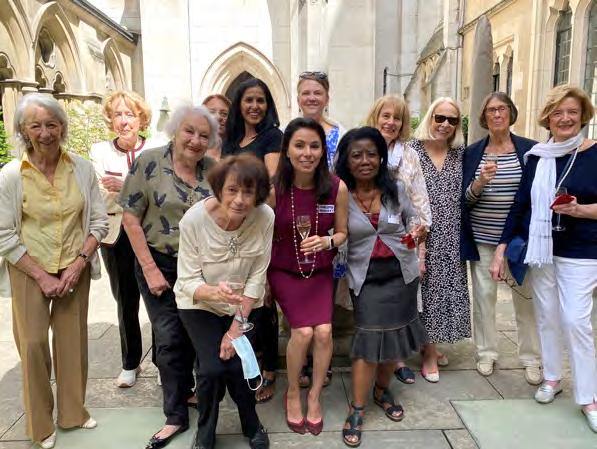
are suffering from natural and political catastrophes. (haieuras.org)
Les Restos du Coeur – Paris concentrates on helping the most needy and fragile members of the population to put food on the table and to have access to basic goods. Since the onset of the COVID-19 pandemic over a year ago, they have been faced with even more people asking for help. (www.restosducoeur.org/associationsdepartementales/les-restos-du-coeurde-paris)
In addition to its usual charities, the JG also donated to Medecins sans Frontiers (www.msf.org) after Ukraine was attacked in the spring, and then organized a “Pop-Up Sale” to raise funds to assist Ukrainian refugees. We donated the proceeds to help support a French/American couple who generously took in Ukrainian refugee women and children near Lille.
Melissa Arnold Adams is president of the Junior Guild. She has been a member of the American Cathedral since 2008.
5
 by Anne Swardson
by Anne Swardson
Cathedral community is searching far and wide for the new Dean
Visioning Team gathers input
Everyone at the American Cathedral is helping search for the new Dean. Following the departure in February of the Very Rev. Lucinda Laird, five teams are approaching the search process from different angles:

· The Visioning Team worked hard over the summer discerning the will and preferences of the parish and Cathedral Friends about who God is calling to be our next Dean. Their work is expressed in an executive summary, survey results and responses to 12 questions that every Episcopal Church is required to answer, along with more than 300 comments from parishioners and Friends given in the survey and in discernment sessions. All of this is on the Cathedral website.
· The Discernment Team, following criteria set by the Vestry and the work of the Visioning Team, will review applications, check references, survey social media and interview applicants prior to selecting a short list to present to the Vestry in the spring.
· The Communications Team is keeping the Cathedral community in touch with the process through Q&A sessions, announcements in the bulletin and e-letter and communications to Friends. The Communications Team also edits documents from other teams, compiled the Parish Profile, and will prepare the public announcement once the new Dean is named.
7
Cathedral community is searching far and wide for the new Dean
· The Prayer Team has signed up more than 55 people to support our search with prayer, prays daily for all involved, ensures that someone is in prayer whenever the Discernment Team meets, may organize vigils when the Discernment Team or Vestry are making final decisions or during the candidate visits, and is writing the prayer for the search.
· The Welcome Team will smooth the path for the new Dean and any family in every way possible, from deanery redecoration to visa help to moral support.
“[The process] allows the Cathedral to capitalize even further on the many gifts and talents of our members,” Senior Warden Ann Dushane and Junior Warden Matt Christensen wrote in a parish letter urging people to sign up for a team. The response was enthusiastic: as many as 100 people will be involved in one or another of the teams.
Even more members will be involved in seeking candidates. The Rev. Canon Linda Grenz, who is serving as transition consultant to the search, noted that the Episcopal Church is going through a severe clergy shortage. True, the Cathedral is a jewel in the heart of Paris, one of the world’s most beautiful cities. But with more churches seeking clergy than clergy seeking positions, Interim Dean Tim Safford also is urging Cathedral members and Friends to spread the word far and wide to find potential candidates.
Anyone interested in the position should submit a resume, Office of Transition Ministry portfolio and letter of interest to transitions@tec-europe.org
The community is also involved in the Visioning Team’s research into where God is calling our parish to go. Over the summer, the committee sent a discernment survey to Cathedral members and Friends, receiving 154 responses to the English version and 12 to the French. In addition, about 40 people attended an all-day session in the nave on July 10, putting notes on a white board and meeting in small groups.
Attendees had interesting responses to the three questions discussed. A sampling:
What is God calling us to be?
“Translators: Between French and American, secular and religious, different communities (making God’s word and intentions understandable).”
“People who find the ‘users guide’ to create a culture of ‘loving our neighbors’.”
“A people engaged with our multiple communities (and a bit more turned towards France & Europe).”
Where is God calling us to go?
“To stretch and challenge ourselves for the good of our cathedral community and for all those around us, all whose lives we may touch.”
“We are called to reinforce and expand our outreach and our in-reach, through service to others, education and programs, musical excellence, pastoral care, the Word and how we choose to interpret and spread it to our community.”
“Into the streets of Paris!”
Who is God is calling to lead us?
“A person with: strong pastoral vocation, outreach experience, international experience – with at least one foreign language skill, French if possible; a leader capable of managing and making the most of a limited staff, and with the capacity to re-think the organization of the staff and church leadership.”
“A person who is committed to his community and to social justice.”
“An interesting, articulate and inspiring preacher who challenges us to apply our spiritual values in our daily lives.”
With visions like that, we can be sure the right person for us is out there somewhere.
Anne Swardson, a longtime member of The American Cathedral, was the Convocation liaison for the French-language mission.
8
Love in a Box is back!
Love-in-a-Box has been a fixture at the Cathedral for 21 years, in its heyday delivering gift boxes during the December holidays to nearly 4,000 underprivileged children. For many parishioners, seeing those colorful stacks of beautifully wrapped boxes in the Nave told them that Christmas was approaching, a visual representation of an outpouring of love and care which showed Christian charity at its finest – giving to those in need, and especially, making the difference in the life of a child.

Bringing joy not only to those 4,000 children every year, but also to their families by extension.
The LIAB program has always had several parts – boxes funded by the Cathedral’s Mission & Outreach Committee (assembled by American Scouts); boxes donated through school drives, and boxes donated by individuals in the community. Distribution happens through a network of charities serving families. In the words of one LIAB recipient: “The idea that someone who didn’t even know me would have made this for me was overwhelming.” She went on to say that this gesture gave her faith in humanity, and made a huge difference in how she thought about the world. She gave it credit as one of the factors which spurred her on to not only study in France, but to obtain her Master’s degree.
In 2020, due to pandemic concerns, the program was paused. Volunteers still made gift bags for Paris Tout P’tits, a charity serving young mothers with small children. In 2021, this effort was expanded with the offering of additional gift bags for adolescent boys served by the Les Midis du Mie, a charity in Paris which helps adolescent boys living in precarious situations, often on the street, and Copains du Monde in Calais, serving the many refugees there. Boxes donated by schools and the community were given to the Association d’Entreaide du Moyen Orient, a charity founded by Bishop Pierre Whalon; the Centre d’Action Sociale Protestant (CASP), Restos du Cœur, and the Armée du Salut
This year, the Love-in-a-Box team is looking forward to getting back to work and to seeing once again the sparkling stacks of boxes heralding the holiday season.
Gift box donations from the public will be accepted at the Cathedral from Wednesday, November 23rd until Wednesday, December 7th, 2022.
Please contact our team at liab.france@gmail. com if you would like to volunteer!
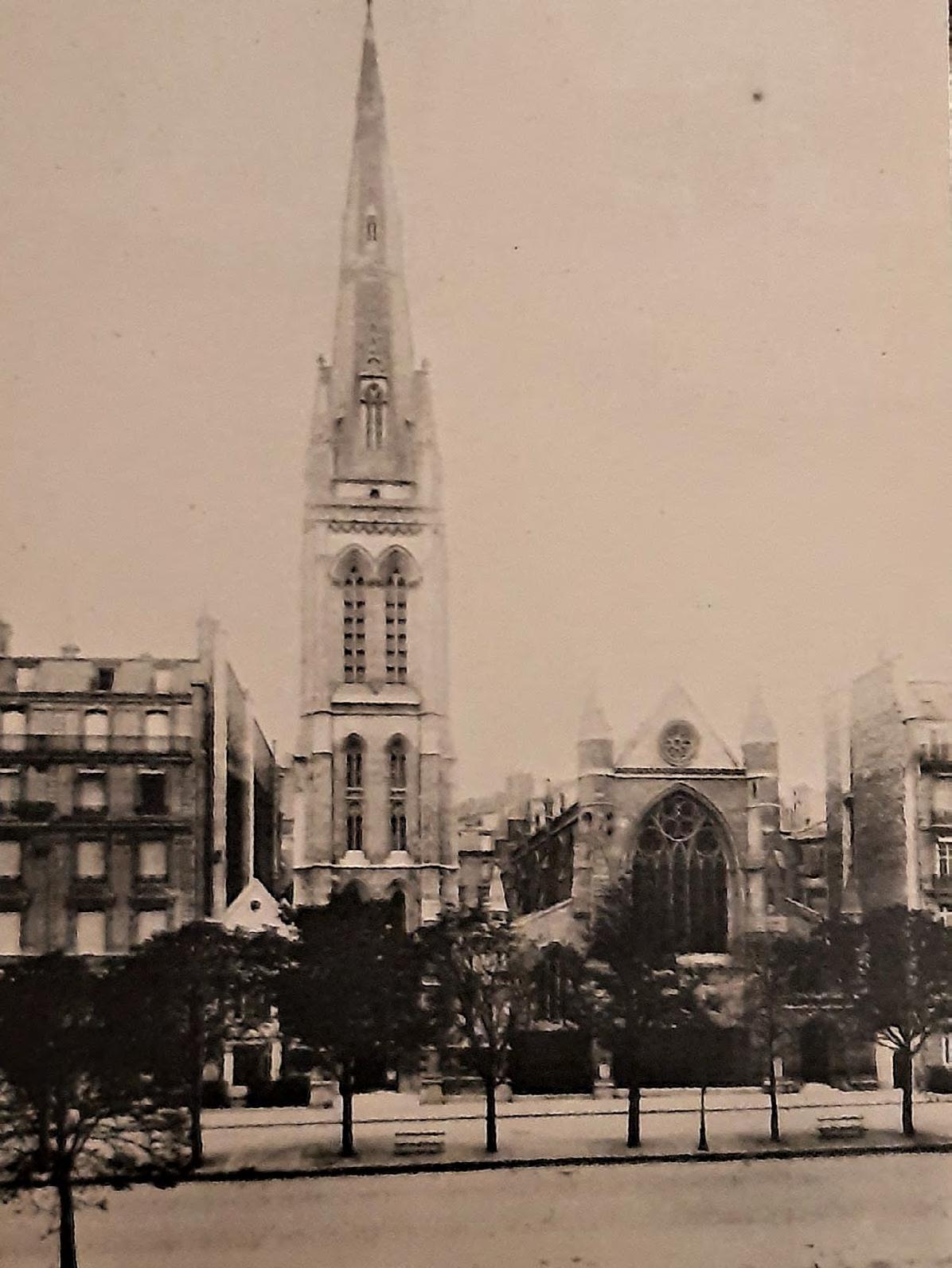 by Ellen Hampton
by Ellen Hampton
The American Cathedral celebrates its centennial
A journey towards inclusion

In March 2023, Holy Trinity will celebrate its centennial as The American Cathedral in Paris, seat of the bishop of the European Convocation of American churches, leader of Episcopal worship on the European continent. Becoming a cathedral was not a step lightly taken a century ago, but preparing the ground was the most critical act: first, Holy Trinity had to become a free church.
Today, most of us have not heard of any other kind. Bishop G. Mott Williams (1857-1923), under whose tenure as visiting bishop-in-charge the change occurred, explained to the Holy Trinity congregation in November 1921 that the idea of pew rentals – asking parishioners to pay an annual fee to reserve a seat in church – had resulted from the American Revolution. British Anglican Church subsidies to American churches ended, sending them scrambling for new ways to gain a basic operating income. Pews were sold, rented, inherited, taxed and otherwise used to produce revenue. Williams said that the system was not meant to be exclusive, but that exclusivity had grown from it “with
sometimes awkward and unpleasant manifestations.” The system lasted nearly 140 years before starting to disappear after 1910, led by churches in the West and then adopted by churches in the East.
“The old system, we found, limited our welcome, burdened or excluded the poor, and suggested to the rich something much less than their duty,” Williams said. “As these things were realized, the old system was first supplemented and then replaced by pure thoughtful, regular and religious giving, advancing to the heights of sacrifice. This is the new spirit we evidence and announce by our action of today.”
Becoming a cathedral also indicated the presence of a bishop. The system from the late 19th century had a U.S.-based Episcopal bishop regularly making a circuit of Europe-based American churches in cities such as Paris, Rome, Munich and Geneva. When the majestically neoGothic Holy Trinity Church was built and consecrated in 1886, there was already talk about creating a seat for a
11
resident bishop there. It had the look of a cathedral from the very first architectural sketch.
Visiting Bishop Thomas A. Jaggar filled in at Holy Trinity in 1912, after the sudden death of the rector, Rev. John Brainerd Morgan. Jaggar discussed with the vestry the possibility of Holy Trinity becoming a cathedral, but without a substantial endowment, there was not enough financial support.1 “To have a permanent bishop-in-charge had long been thought desirable,” vestry notes for the meeting attested, quoting Jaggar in defining Holy Trinity’s role: “It holds a place, not only in relation to our whole Episcopal Church, but to our common Christianity, and to the historic church in its purity, which gives it a strategic importance second to none in our whole communion.”

A committee to consider the cathedral idea was proposed, but with the arrival of a new rector, Rev. Samuel Watson, came the First World War, and all his attention and care were taken up by the needs of refugees, orphans and other war victims. At its close, Watson and his wife returned to the United States, and an army chaplain from Pennsylvania, Rev. Frederick Beekman, was named his successor as rector. Beekman had been dean of the Nativity Cathedral in
Bethlehem, PA, before joining the American Expeditionary Forces in 1917. Less than a week after Armistice was declared in November 1918, the vestry voted to establish a War Memorial and Thank Offering Endowment Committee. The goal was to create both a monument to Americans killed in World War I and an endowment that would support the church. Beekman departed immediately on the first of three lengthy fundraising tours of the United States.
In the meantime, pew rentals continued to provide a significant amount of church revenue. In a July 1920 report, the vestry indicated that 233 places in pews were rented for 38,815 FF (about $150,000 in today’s currency), just over a third of the rental places available. There were also 179 chairs and benches in the back of the church that provided free seating. Vestry members noted that some rents were subscribed but not paid, some pews were rented by people living in the United States and not attending services, and some accounts had been suspended. What were ushers to do if a former renter attempted to occupy an unpaid pew?
BISHOP G. MOTT WILLIAMS
In October 1921, the vestry queried 122 pew holders as to whether they wished to continue the system or convert to a free church. Only two parishioners expressed opposition; most were in agreement and promised to continue to support the church with donations. The vestry voted to abolish pew rentals as of November 1, 1921.
At the same time, the church offered pews for endowment, in conjunction with the War Memorial. Rev. Beekman reported to the vestry in August 1921 that nine pews had
12
The American Cathedral c elebrates its centennial
“The old system, we found, limited our welcome, burdened or excluded the poor, and suggested to the rich something much less than their duty.”
RT. REV. CHARLES BRENT AND HOLY TRINITY DEAN FREDERICK BEEKMAN
been endowed and should be withdrawn from rental. The first two pews were endowed by Vanderbilt sisters-in-law for $12,500 in memory of William K. Vanderbilt, who died in 1920. William K. Vanderbilt and his wife, Anne Harriman Vanderbilt, had provided generous funding to support France during the war, including buying the first 10 airplanes of the Lafayette Escadrille and ambulances for The American Hospital of Paris. Emily Vanderbilt Sloane later also endowed a pew to her second husband, the former U.S. ambassador (and Holy Trinity vestryman) Henry White, after he died in 1927. An heiress to the Astor fortune and an heiress to the Whitney fortune, both prominent New York widows, also were among the first to endow memorial pews. And communities with strong ties to Holy Trinity, such as Grace Parish in New York and the Commonwealth of Massachusetts, endowed pews as well. Today, there are 29 memorial pews in Holy Trinity, the most recent one dedicated by Craig Stapleton, former U.S. ambassador to France, in honor of Flem Stapleton, a cousin who was killed in WWI.

With Beekman’s successful fundraising trips, collecting 600,000 FF ($1.5 million today) between 1920 and 1923, plans for the War Memorial moved forward. In the summer of 1920, a Committee on Art and Artistic Advice, led by American artist Walter Gay, began consideration of how to honor Americans killed in the war. In July 1922, the committee recommended approval of a design offered by architect Bertram Goodhue, with sculptors Michel Tarnowsky and Mahonri Young contributing their work. Four bays along the cloister wall contain the engraved names of 69 American military and civilian units whose
members were among the 116,000 casualties of the war.
In September 1922, Rev. Beekman attended the General Convention of the Episcopal Church in Portland, OR, presenting a spread of arguments in favor of a seated bishop for Europe: such a position would bind the American churches in Europe more closely together, it would oversee the growth of American worship in Europe, and it would provide American Episcopal representation to the European Protestant churches. “For we conceive that the best qualities of mind and heart are requisite for a Bishop who would represent in Europe not our few churches, but the whole church at home and in a very real way, America itself, and American Christianity,” according to the convocation statement.
Beekman reported great interest among the Convention’s 4,000 delegates in Holy Trinity’s Memorial Battle Cloister, as well as in its endowed Memorial Pews. Nonetheless, the General Convention did not take action to create a resident bishop. The vestry of Holy Trinity continued its drive, approving unanimously on December 12, 1922, a resolution to offer the church as the bishop’s seat as a “ProCathedral” (a church holding the bishop’s seat but run by a dean and vestry). Bishop Williams responded immediately: “I accept this offer for myself while in charge, and will use my fullest influence to make the Cathedral idea important and acceptable to my successor. Anticipating very happy relations, I hereby subscribe this acceptance.”
The consecration of the new American Cathedral was scheduled for January 1923, but Bishop Williams was ill, and it was postponed until March 18, 1923. Approving cathedral status for Holy Trinity was his final mission: he died a month later, on April 14, in Paris. At the next General Convention in 1925, Beekman and the vestry resubmitted their arguments for a seated bishop, adding that such a position should not be combined with the duties of a parish rector, and leaving open the question of financial support. “We are painfully conscious of our inability at this time to contribute financially in any larger measure than we did before the war, when we barely provided a sum sufficient to defray the necessary traveling expenses of the Bishop for a biennial visitation,” the statement said.
The General Convention decided to postpone any decision until its next meeting in 1928, but in the meantime appointed as visiting bishop-in-charge Rt. Rev. Charles Brent, a churchman with wide international experience,
13
who served until 1928. When the 1928 Convention met, Bishop Brent and his successor, William Lawrence, requested a further delay. Thus, the bishop-in-charge remained a visitor to Europe until 1960, and even then, those who resided in Europe chose their city at will, several of them living in Geneva or Frankfurt. Dean Sturgis Lee Riddle (1948-1974) noted in a memoir that Holy Trinity’s cathedral status remained somewhat symbolic. “It is essentially self-governing under the rector-dean and the vestry, with its status as “cathedral” largely symbolical, having to do with the fact that it is the largest and soundest of the parishes,” Riddle wrote.2
It was not until 1994, when Bishop Jeffery Rowthorn, Welsh-born, Connecticut-based, took the post that Holy Trinity began to fulfill its role at the heart of the convocation (see accompanying article). Since then, the Convocation’s original seven churches have grown to nine, along with a dozen missions and congregations.
Shortly after the parish church of Holy Trinity became The American Cathedral in Paris, it also inaugurated the first U.S. national memorial to the fallen of WWI. The Battle Cloister Wall was dedicated on Memorial Day, May 30, 1923, with a ceremony bringing together commanders of the Allied forces (United States, Britain, Belgium, Italy), as well as former French President Raymond Poincaré and Maréchal Ferdinand Foch.

“The church of the Holy Trinity was indicated for these national memorials, not only because it is a church with a notable war record to carry these memorials,” Ambassador Herrick said in his address. “[...] I like to think of the graves of our men lying so close to our Allies so that for all future time American soldiers will be mounting a silent guard, close in death as in life to their valiant comrades. It seems to me that, in the watches of the night, there must be spirit voices calling to one another, asking: ‘Brother, is it well with thee?’
“The answer to that question depends on you and me, and all of our respective countrymen, for whom these soldiers made their great sacrifice. Let it ever be solemnly borne in mind that this generation, and the generations to come, are trustees of this sacred heritage.”
Ellen Hampton is a historian and author, and member of the Cathedral archives committee. She is editor of Trinité magazine.
Endnotes
1. Cameron Allen, The History of the American Pro-Cathedral, Church of the Holy Trinity, Paris (1815-1980), p. 527
2 . Ibid., p. 640
The American Cathedral celebrates its centennial
“Let it ever be solemnly borne in mind that this generation, and the generations to come, are trustees of this sacred heritage.”
U.S. AMBASSADOR TO FRANCE MYRON T. HERRICK
by Sophie Belouet
How the Convocation (finally) got a seated bishop
From 1923, when Holy Trinity was consecrated a cathedral, it took seven decades for a full-time bishop to take up residence in Paris. In the early years, the parishes in four European nations that comprised the Convocation of American Churches belonged to a loose network with little contact or exchange. Most of the bishops who attended the Convocation were retired, part-time messengers who hopped across the Atlantic once or twice a year to perform episcopal duties such as confirmations. But in 1971 and 1972, two major changes took place that were to change the course of the Convocation and its parishes: the establishment of the Nice Fund and the appointment of the first resident bishop.
The Church of the Holy Spirit in Nice, financed mainly by donations from wealthy expatriates who spent “the season” on the French Riviera, was consecrated in 1888. The parish thrived for many years, but by the 1960s its congregation had dwindled, and it had to rely on subsidies from the National Church to survive. Title to the property was held by the Board of Foreign Parishes, a New-York based body established in 1859. In 1971, the Board decided that the church was no longer sustainable and that the property should be sold and the congregation merged with
the Anglican parish in Nice. This decision caused great consternation amongst the parishioners, and vestryman Howard Faust brought suit in New York to block the sale. The suit was lost, but the decision of the court stipulated that the proceeds of the sale were to be invested under
the supervision of the Board of Foreign Parishes and the income was to be used for the ministry of the Episcopal Church, first in Nice, secondly on the Riviera and thirdly in Europe. This was an important decision as it provided

15
“A full-time salaried bishop would bring the added energy and skills to exploit new opportunities opening up. The problem was how to fund it.”
funds for the development of ministry and mission in Europe.
That same year, Bishop Edmond Browning was appointed by the Presiding Bishop of the Episcopal Church to be the first resident bishop in Europe. Bishop Browning settled in Wiesbaden with his large family and set to work to federate the Convocation parishes more closely. For the first time, they realized that they were not alone in Europe, and timid exchanges began to take place. After Bishop Browning’s term, the post was held by a number of recently retired diocesan bishops who relocated their headquarters to Paris: Bishops Ervin Swift, Richard Millard, John Krumm, Robert Appleyard, Donald Davies, and Matthew Bigliardi. They further cemented the dynamics and the bonds forming within the Convocation, preparing the way for the next big step, the appointment of the first full-time salaried bishop of the Convocation in 1993.
During the early years of the Convocation, finances were purely on a parish level since there was no Convocation bishop or staff and no common program for mission on a Convocation level. Change occurred with the arrival of Bishop Browning, whose salary was paid by the National Church, and with access to the Nice Fund, which financed the beginning of activities in the Convocation. The retired bishops who subsequently served the Convocation already drew their pensions; their housing and travel expenses were paid by the National Church and the Nice Fund. The Convocation parishes began paying assessments to cover
administrative and other costs. At that time, the Board of Foreign Parishes had little contact with the parishes in Europe and, wanting to ensure the correct use of the Nice Fund as stipulated by the court decision, required that each expenditure (for example, a stipend for an American priest on staff at the Anglican Church in Nice or travel costs for an episcopal visitation to one of the parishes) be the object of a detailed reimbursement request with the supporting justifications. This procedure became very cumbersome as the activities of the Convocation increased, and a system creating an annual budget for mission projects was developed. Happily, closer relations were being forged between the Convocation and the Board through the good offices of the bishops-in-charge, the Presiding Bishop and the people of the Convocation who served on the Board.
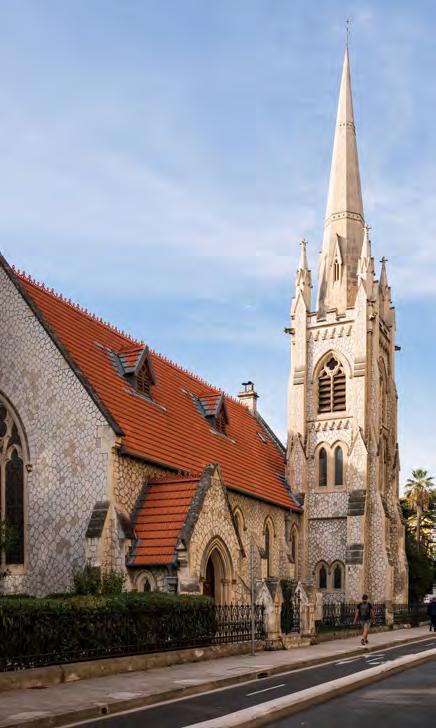
16
How the Convocation (finally) got a seated bishop
CHURCH OF THE HOLY SPIRIT IN NICE, FRANCE
“Change of finances occurred with the arrival of Bishop Browning, whose salary was paid by the National Church, and with access to the Nice Fund, which financed the beginning of activities in the Convocation.”
by Helena Mbele-Mbong
When Bishop Bigliardi began to consider stepping down as Bishop-in-Charge in the early 1990s, the question was raised about what form his succession would take. The Convocation leaders, the Board of Foreign Parishes and the now-Presiding Bishop Browning all recognized that the Convocation was growing in size and vigor, which called for a new model. A full-time salaried bishop would bring the added energy and skills to exploit new opportunities opening up. The problem was how to fund it.
As Convocation Treasurer, I drew up a five-year projection of the related costs and flew to New York to discuss it with Board Chairman Conner Fay and the Rev. Richard Chang, the Presiding Bishop’s right-hand man. After three days of negotiations, we reached an agreement on how the costs could be shared, and the Presiding Bishop embraced our plan and appointed Jeffery Rowthorn as the first full-time salaried Bishop-in-Charge in 1994. Under the leadership of Bishop Rowthorn and his successors, the Convocation has gone from strength to strength with new missions and ministries joining the older parishes, all knit together in a growing sense of community and common mission within the Convocation, which today has grown to nine parishes and a dozen missions and ministries.
Bishop Rowthorn (see accompanying article) also was the last appointed bishop. He oversaw the Mission 2000 statement, among whose goals was to elect the next bishop, and sponsored a resolution requesting permission of the Presiding Bishop for such an election. Bishop Pierre Whalon was elected in 2001, and Bishop Mark Edington, the current bishop, was elected in 2018.
Bishop Jeffery Rowthorn builds the Convocation as community
The Convocation has experienced extraordinary growth over the last 30 years of Episcopal Churches in Europe, largely set in motion by Bishop Jeffery Rowthorn. From the 1970s to the early 1990s the parishes of the Convocation gradually became more connected, but it was increasingly recognized that real growth and strength would depend on a full-time, resident bishop. As a previous resident bishop, Presiding Bishop Edmund Browning readily saw the possibilities. In early 1994 he appointed Bishop Jeffery Rowthorn, originally from Wales, who had been serving Connecticut as Suffragan Bishop, to be our full-time, definitely not retired, Bishop-in-Charge.
Sophie Belouet, a member of the Cathedral since 1971, has served multiple terms on the Vestry between 1989 and 2021, was Treasurer of the Convocation from 1984 to 1999 and a member of the Board of Foreign Parishes from 1989 to 2004. She serves as Associate Treasurer of the Cathedral.
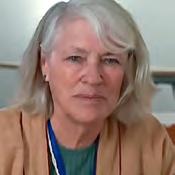
Bishop Browning’s decision proved a dual blessing for the Convocation. To have a permanent, full-time bishop would have been reason enough to rejoice. But in the figures of Bishop Jeffery and Anne Rowthorn, the churches in Europe gained immensely from the wisdom and experience of two unique and remarkable individuals. Bishop Jeffery had been a much-beloved professor at the Berkeley Divinity School in New Haven, CT, and brought not only strong teaching skills but also former students who, now ordained, began taking posts in our congregations. As for Anne, a recognized teacher and author in her own standing, she drew on her writings to encourage, in ways large and small, discernment of the gifts of the laity and their greater participation in the life of the church.
Bishop Jeffery quickly set about building up the ministries and life of the Convocation to make it into the vibrant,
17
BISHOP JEFFERY AND ANNE ROWTHORN
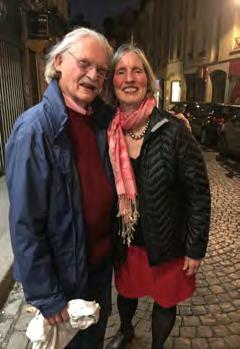
18 lively group of parishes and missions, with active Convocation commissions and committed members that it is today. One of the first things he did was appoint a Commission on the Ministry of the Baptized (COMB). He named it such, and not just “Commission on Ministry” as called for in the Canons, because he wanted this Commission to be concerned with ministry of all, not just clergy. For the first four years, this was the only commission, tasked with developing profiles of clergy for the Convocation and programs to grow ministry. The results included interviews of candidates for Holy Orders, some of whom went on to study and to serve in the Convocation or elsewhere; the first Youth Across Europe event, and the first study guide written specifically for use in Convocation parishes, “A Journey without Maps,” aimed to lead parishioners and parishes to consider where God was calling them.
In 1996, Bishop Jeffery closed a lively Convention in Frankfurt with a sermon on the “Yellow Brick Road.” We were skipping down it, not sure where it was leading, but the Holy Spirit was definitely leading us to new places. By then, the fire had begun to catch us all. With Rev. Karl Bell of Wiesbaden, the idea evolved of a cross that would go on a pilgrimage to all the parishes and missions of the Convocation in 1997, the 1,400th anniversary of St. Augustine’s pilgrimage from Rome to Canterbury. Rather than lend the Convocation a cross, Canterbury Cathedral made us a cross from an ancient beam removed from the Cathedral during renovations, with the years 597 and 1997 carved into it. Bishop Jeffery led us in a renewal of our baptismal vows at each stop along the pilgrimage through the parishes. By the time Youth Across Europe carried the cross into the 1997 convention at the American Cathedral in Paris, with Presiding Bishop Browning in attendance, the Convocation was no longer a scattering of parishes with little interaction but a community of parishes and missions
with a broader purpose. The cross continues to be handed over from the host parish of the current convention to the host parish of next year’s convention – a living symbol of our pilgrimage together.
At the same time, it was recognized that COMB could no longer do it all and COMB itself needed some refocusing. Anne Rowthorn had been the main instigator in organizing the Youth Across Europe event. Clearly a separate Youth Commission was needed to provide greater support to youth activities in the parishes and organize more Convocation-wide events. Youth Across Europe, gathering young people from across the Convocation for study, activity, and fellowship, became an annual event, connecting our youth and leading to lasting friendships. Eventually, Juniors Across Europe and a young adult retreat were added. Our young people look forward to this time together, sharing stories across time and space.
The next pivotal event put in motion by Bishop Rowthorn, with the Council of Advice, was the Mission 2000 conference, which met in 1999 in Nice. (Our mission vision gatherings are always looking ahead). Bishop Rowthorn invited Rev. Ian Douglas, then Professor of Mission and World Christianity at Episcopal Divinity School in Cambridge, and the Rt. Rev. Michael Nazir-Ali, Bishop of Rochester, England, to speak on Anglican identity and the shape of the church to come. Participants, purposely including many not previously active at the Convocation level, were invited to dream far into the future and imagine what the Convocation might be like. Energized by the possibilities suggested by the speakers, the participants
Bishop Jeffery Rowthorn builds the Convocation as community
“Bishop Jeffery brought a vision of what the Convocation could be. From that vision came concrete proposals and actions developed and carried out by all involved.”
shared ideas from the practical to the wild, eventually focusing on six goals. We wanted to become a diocese (and elect our own bishop); establish a training center and program for lay and ordained ministries; develop a youth mission; form an Anglican Province of Europe; plant new mission churches and create multicultural European forms of Anglicanism.
All these goals would take work; some would take longer than others. One was recognized by the Presiding Bishop: though still not a diocese, we now elect our own bishop. The European Institute for Christian Studies was another direct outcome of Mission 2000, which also set a precedent for major workshops to develop mission strategy for the next five to ten years. The goals of Mission 2000 are still very much with us.
in Madrid in May 2003 (by which time Bishop Pierre Whalon was with us). This conference affirmed our common mission and outlined steps that could be taken toward having the jurisdictions work more closely together, sharing episcopal oversight, and ultimately looking toward a new organization. COABICE still meets and continues to be important to the life of our churches in Europe.
Bishop Jeffery brought a vision of what the Convocation could be. From that vision came concrete proposals and actions developed and carried out by all involved. He had a way of tapping people on the shoulder and asking them to do something; of laying out challenges and possibilities to commissions. Entrusted by Bishop Jeffery and by the Holy Spirit, with the leeway to dream, suggest, and act, individuals and commissions responded by taking the challenges and running with them. Whether the final meeting of the first group of COMB members discussing what form and direction COMB should take after four years, or Mission 2000, he most certainly had ideas – but he always allowed the groups to define where they were going. He gave broad direction, raised possibilities, programs, and leaders, growing the Convocation to the active community of parishes, missions, and involved members it is today.
A fourth major development with Bishop Rowthorn’s arrival was the beginning of a concerted effort for the bishops of the jurisdictions of the Anglican Communion in Continental Europe to work more closely together.
COABICE, the College of Anglican Bishops in Continental Europe, began meeting at least once or twice a year. These five bishops (of the Lusitanian Church in Portugal, the Reformed Episcopal Church of Spain, the Diocese in Europe of the Church of England, and the Convocation) soon realized that they needed to involve both clergy and laypeople. Beginning in 1998, a layperson and a clergy member from each jurisdiction joined the bishops in meetings, bringing the conversations from the ecclesial level to the pews, as it were. Discussions led to a Partners in Mission (PIM) process that began in all the parishes of the four jurisdictions, working up through synods and conventions, culminating in a PIM conference
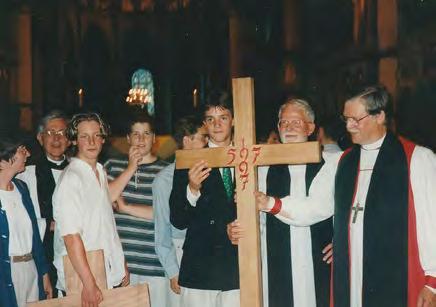
The much-loved Rowthorns returned to the United States in 2001 but remain with the Convocation in spirit. In recognition of all they had done for the Convocation, the Rowthorn Fund was established to provide funds particularly for youth and mission development. They have returned on several occasions to attend Convention and other events, many are in contact with them, and some have been able to visit them at their home by a stream in Connecticut. Together they have left an indelible mark on the Convocation.
Helena Mbele-Mbong has been an active member of Emmanuel Church in Geneva since she and her family arrived there in 1984. A member of the choir from the beginning, she has served on Vestry and other committees at Emmanuel; COMB, Council of Advice, Finance Committee, and EICS in the Convocation; has been a deputy to General Convention and served on the Standing Commission on World Mission and the EC Committee on the Status of Women of The Episcopal Church; and the International Anglican Women’s Network of the Anglican Communion. Deacon Richard Cole and Carole Ducastel also contributed to this article.
19
BISHOP ROWTHORN WITH THE CANTERBURY CROSS AND MEMBERS OF YOUTH ACROSS EUROPE IN 1997.
The Blessing of the Animals


The Blessing of the Animals is held annually in honor of the feast day of Saint Francis of Assisi (October 4th). This year, the Cathedral was delighted to welcome many four-footed friends and to recite Saint Francis’ iconic Peace Prayer: Lord, make me an instrument of your peace: where there is hatred, let me sow love; where there is injury, pardon; where there is doubt, faith; where there is despair, hope; where there is darkness, light; where there is sadness, joy.

20
NOÉMIE BRINGS PETROUCHKA THE CAT AND ROSY THE RAT FOR A BLESSING, A PERFECT EXAMPLE OF SAINT FRANCIS’ ADVICE ON DEALING WITH ADVERSARIES
All things bright and beautiful All creatures great and small
CANON NAT KATZ SPREADS THE LOVE
Photo Credit: Lauren Van Weyenbergh of Studio Reverie





All things wise and wonderful The Lord God made them all
STELLA MARIS STURMAN, OF THE LAGATTO ROMAGNOLO BREED, CONSIDERS THE CONGREGATION.
 by Nancy Janin
by Nancy Janin
Musical and mechanical genius in our historic organ
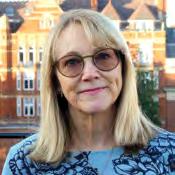
Among the many legacies left to us by our generous founders, the historic Cavaillé-Coll organ is one of the greatest. On any given Sunday, the congregation is blessed by its beautiful and powerful sound, without knowing why it is so fine, or to whom we owe the joy. The answer is the pure and prolific genius of Aristide Cavaillé-Coll (1811-1899).
Paris Conservatory organ professor Charles-Marie Widor, his contemporary, described the innovation and brilliance of a Cavaillé-Coll organ: “[…] The freedom of mixing timbres, the means of intensifying them or gradually tempering them, the freedom of tempos, the sureness of attacks, the balance of contrasts, and, finally, a whole blossoming of wonderful colors – a rich palette of the most diverse shades: harmonic flutes, gambas, bassoons, English horns, trumpets, celestes, flue stops and reed stops of a quality and variety unknown before.”1
Cavaillé-Coll’s innovations in organ design revolutionized organ playing and composition, leading to an entirely new type of organ music. He built more than 600 instruments in 32 countries that affirm his influence far beyond his native France. In Paris, Cavaillé-Coll organs grace the
Cathedral of Notre Dame, the Basilica of St. Denis, the churches of St. Roch, Madeleine, St. Sulpice and NotreDame d’Auteuil, as well as the American Cathedral of the Holy Trinity.
Born to an organ-building family in Montpellier, CavailléColl showed mechanical talent early on. By 1822, at age 11, he was working alongside his father and two brothers in the family atelier in Toulouse with miniature tools to fit his small hands, and by 14 he was formally an apprentice. His curious mind and exceptional intelligence led him to also study informally with local mathematicians. At age 22, he created a circular saw and won a national prize for it.
By 1829, 18-year-old Aristide Cavaillé-Coll was sent alone to Lerida in Spain to complete a half-built organ. This was the first time he had the freedom to showcase his own talents and creativity, and the organ was considered a triumph, especially his inclusion of the new-fangled swell box, which allowed the organist to create crescendos and decrescendos of tone. Back in Toulouse, he met Italian composer Gioacchino Rossini, who with many Parisians had fled the city due to a cholera outbreak. Rossini was looking for an organ for an opera production and contacted
23
Musical and mechanical genius in our historic organ

the up-and-coming local organ builder. Cavaillé-Coll offered one of his own inventions, a “Poikilorgue,” a precursor to the harmonium used in salons and theaters. Whether it was the instrument or the young man himself that impressed Rossini, he persuaded Cavaillé-Coll to move to Paris, where organs were being built by the dozens. Further, he provided letters of introduction that put Aristide in touch with all the cultural impresarios in the capital.
Thanks to one of those contacts, a few days after he arrived in 1833, he heard about a prestigious project to design an organ for the Basilica of St. Denis; the only problem was that the bidding period was closing in three days. CavailléColl rushed to the site, drew up a plan, and just before the deadline delivered his proposal. It was accepted over all the other major organ makers; his design’s many innovations had impressed the powers that be.

For the St. Denis organ, Cavaillé-Coll redesigned the bellows, which he believed were the most important element of organ construction. Rather than pinched on one side, opening fully only on the other, he created box bellows that pushed the air out more evenly and efficiently. This new design could be more easily worked by teams of bellow blowers, stepping up and down on protruding struts under the bellows. (Picture a row of Stairclimbers in a gym). Cavaillé-Coll also came up with a genius solution to the difficulties of varying the bellows’ pressure on pipes of differing lengths and widths. Those sounding higher frequencies need a higher pressure, so he decided to build blocks of bellows of differing sizes connected to the different ranks of pipes, the divided windchest. The higher pressures of the new bellows were felt directly by the organist through the fingers and some organs became physically difficult to play. He therefore included a new British invention, Barker levers, which allowed the pressure on the keys to be offset. A small bellow called a pneumatic is inflated by the organ’s wind supply and placed under each pipe to overcome the resistance of the valves. Thus louder and more powerful organs can be played by the human hand.
Most importantly, he turned his practical mind to the issue of registration – the combination of stops that are used at any one time and that give the special tonal quality
24
ABOVE, THE ORGAN SECTION AT THE REAR OF THE CATHEDRAL. BELOW, AN ORIGINAL CAVAILLÉ-COLL SKETCH FROM HIS NOTEBOOK OF DESIGNS. BIBLIOTHÈQUE NATIONALE DE FRANCE.
“The ability to change the tone and thus the mood and the message of the music during a performance was astounding.”
to the sound produced. Until Cavaillé-Coll, organists had to set the registration at the beginning of a piece and continue until the end. Cavaillé-Coll devised a system where the organist could set up alternate registrations that were on call, “appel,” and switch to the new registration with a simple maneuver. The ability to change the tone and thus the mood and the message of the music during a performance was astounding and liberated organists –and soon composers – to express complex and changing musical ideas.
The radical changes Cavaillé-Coll brought to the mechanics of organs gave the instrument an enormously enlarged scope, which completely changed organ building. It has been compared to the evolution from a harpsichord to a piano; in the organ world there is a pre- and post-CavailléColl. Although he played no instruments himself, his musical sense and taste were valued by the organists who worked with him. When people speak about his genius, they often are not referencing his mechanical inventions but his sensitivity to the unique sound desired for each space. For all his talent in mechanics, he was truly driven by his desire to create beautiful sounds.
For example, his organ at St. Sulpice, built in 1862 for a large church with a seminary attached, differs greatly from the sound of the rebuilt organ at the Cathedral of Notre Dame de Paris, completed six years later. In the former he went for subtlety and flexibility, knowing it would be used for a wide variety of services. Notre Dame was the national cathedral and thus he created a much bigger, more imposing style. (The organ has since been rebuilt significantly from his original design.) While he often had
to work with existing cases and architectural limitations, another facet of his genius, demonstrated in all his organs, was in organizing the different pipes to produce the best sound in the space. He considered the acoustics of the space an additional stop in his organ building.
Thanks to Cavaillé-Coll, organist composers found many wonderful, exciting new organs to play, and after some grousing by critics (the organs sounded too secular, they were flashy and lacked depth) young musicians began responding to the new possibilities with a new kind of music. A seminal work is the 6th Symphony, not to mention the most well-known organ piece, the Toccata from the 5th Symphony, by Charles-Marie Widor, who became the organist at St. Sulpice in 1870. He dazzled audiences with the range of sound Cavaillé-Coll’s instrument had to offer. Among other composers who adapted their work to the enormous versatility of sound available in the new organs were Cesar Franck, Camille Saint-Saens and Louis Vierne.
With only a hiatus during the 1870 Prussian war and siege, when Cavaillé-Coll’s workshop on the avenue du Maine shut down, he worked hard at organ-building from 1829 until his death in 1899. He had established himself as France’s pre-eminent organ builder with the Basilica at Saint-Denis (1841), and La Madeleine (1846), but his most prolific period came during the reign of Napoleon III and his prefect Baron Haussmann. He completed organs for Saint Vincent-de-Paul (1852), Sainte-Clotilde (1858), Saint Sulpice (1862), Notre-Dame Cathedral (1867), and SainteTrinite (1869) in that period.
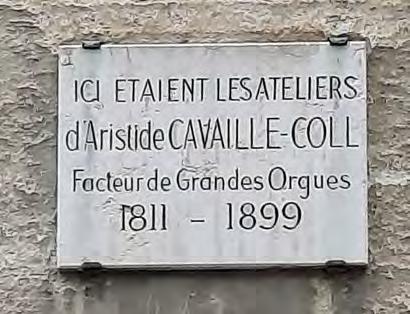
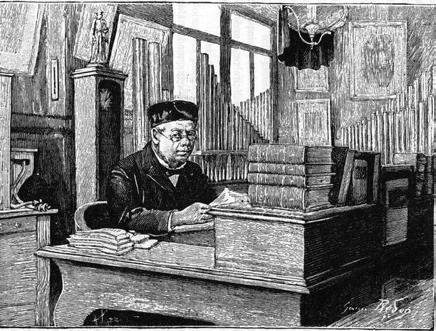
25
ENGRAVING OF ARISTIDE CAVAILLÉ-COLL FROM L’ILLUSTRATION MAGAZINE, 1894.
PLAQUE ON THE WALL OF HIS FORMER MANUFACTURING WORKSHOP AT 13, AVENUE DU MAINE IN PARIS.
by Nancy Janin
Feasibility study: Let there be music and light
The people have spoken and the answer is a resounding “Yes!” In June, a feasibility study was sent to over 800 households – parishioners, Friends of the Cathedral, and others who have in various ways been connected to the Cathedral community – to see if there was interest and support for undertaking six capital projects, by far the most important being the restoration of our Cavaillé-Coll organ. The responses were anonymous and seen only by the Cathedral’s fundraising consultant, Maurice Seaton. He reported that 93 percent of respondents support undertaking a capital campaign and that gift indications allow us to embark on a 4.2 million euro fundraising effort, with a possible stretch goal of 5 million euros. On September 8 the vestry approved moving forward immediately.
halls as well as some churches. The acoustic can be adjusted to dampen or increase reverberation with the touch of a button to enhance the sound of all the different types of events that take place in the nave;
4/ Finally, funds raised over and above the final cost of these projects will be invested in endowment, which supports our excellent music program.
Of the six projects presented, four will be pursued:
1/ Extensive renovation of the organ with new consoles, relocation of existing pipes and addition of new pipes, and all new organ cases;
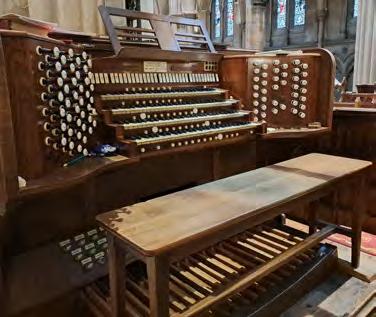
2/ Conversion of the nave lighting to LED and division into sectors that will allow flexibility for worship, concerts and other events.3/ Correction of the overly dry acoustic of the Cathedral, which is a hindrance to congregational participation, by installing a sophisticated system used in concert
Two of the six projects presented have been eliminated from consideration at this phase. While many expressed the desire to address the high usage of paper for our service bulletins, there were few who believed electronic screens were a good substitute. The question of replacing some or all of the pews with chairs revealed strongly held but opposing viewpoints, to such an extent that this possibility needs to be discussed much further within the parish before any decision can be made.
After the capital campaign leadership has been recruited and the supporting materials approved, a quiet phase will begin when major donor prospects will be asked to make pledges. In early 2023, a very wide audience will be solicited for gifts, including corporate and governmental sources and those who have been enjoying our organ recitals virtually these past two years. Our hope is to reach our fundraising goal by March 2023, when the Presiding Bishop will be at the Cathedral, celebrating its 100th anniversary. And then the works will begin!
26
“Gift indications allow us to embark on a 4.2 million euro fundraising effort, with a possible stretch goal of 5 million euros.”
Thus, in 1886, when Holy Trinity founders went looking for an organ, they turned to Cavaillé-Coll. American interaction with the Paris social elite ensured the founders would have heard Cavaillé-Coll’s house organs at the homes of their friends and families. For example, Winnaretta Singer, Princess de Polignac, an American-born patron of musicians, had a Cavaillé-Coll organ installed in her home. She and her brother, Mortimer, a Holy Trinity parishioner and acquaintance of Cavaillé-Coll, were among the many children of Isaac Singer of sewing machine fame. In the 1920s, American composers such as Melville Smith, Aaron Copland, Elliot Carter, Walter Piston and Virgil Thomson listened to composer Nadia Boulanger’s 1905 Cavaillé-CollMutin organ while studying at her Paris home.
The vestry contracted in June 1886 with Cavaillé-Coll for a 36-stop three-manual organ, but when installed in September 1887 it had grown to 45 stops. The inaugural concert was played by the famous Alexandre Guilmant whose great-great-grandson, Cyril Lerouge, has sung counter tenor in the Cathedral choir for several years. In 1922 10 new stops were added, bringing more depth and color to the pedal division in particular, as changing repertoire demanded. This work was undertaken by the
Musical and mechanical genius in our historic organ
firm Cavaillé-Coll-Mutin (Charles Mutin entered the firm as a 14-year-old apprentice and went on to become CavailléColl’s successor). In 1930 the firm Cavaillé-Coll-MutinConvers rebuilt the wind bellows, the windchests and incorporated new technology, which allowed the addition of five orchestral stops. Interestingly, this firm had sent two technicians to study organ building with the American Ernest Skinner upon the strong recommendation of the Cathedral’s own organist, Lawrence K. Whipp, and they applied their new know-how on our organ.
The final iteration of Cavaillé-Coll’s company, including Pleyel, still a major piano building company, closed its organ division at the time of the Second World War. But the reputation of Cavaillé-Coll lives on, as do many of his instruments, including our own, which is considered one of his masterpieces, the only one built for an Episcopal church. If the funding is forthcoming, it will be completely renovated and restored in the coming years (see article on the Feasibility Study). According to Dr. Carolyn Shuster Fournier, a Cavaillé-Coll scholar, “The new organ at the American Cathedral will maintain all of this organ’s historic pipework. This will not only be one of the finest organs in Paris but in the entire world. This magnificent organ will not only ensure beautiful liturgical services, but will open doors to sharing beauty with musicians throughout the world.” Our historic Cavaillé-Coll is indeed a precious legacy we are proud to pass on to the next generations.
Nancy Janin, who lives in London, is Senior Editor of Trinité magazine, Treasurer of the American Cathedral in Paris Foundation, a member of the Board of Foreign Parishes, and serves on the leadership team of the capital campaign.
Sources: “The Genius of Cavaille-Coll”, five DVD set, winner of 2014 BBC Music Magazine DVD documentary of the year; Dr. Carolyn Shuster Fournier, former American Cathedral organist (1988-1989), honorary titular of the 1867 Aristide Cavaillé-Coll choir organ at Ste. Trinité Church, Paris, PhD dissertation on Cavaillé-Coll secular organs; Andrew Dewar, Cathedral Organist; Zachary Ullery, Cathedral Music Director; and many on-line sources including most importantly Vox Humana Journal.
1. Charles-Marie Widor, “Avant-propos to the organ symphonies,” from John R. Near, Widor: A Life Beyond the Toccata (University of Rochester Press, 2011).

27
FROM CAVAILLÉ-COLL’S NOTEBOOK, THE SCIENCE OF ORGAN-BUILDING. BIBLIOTHÈQUE NATIONALE DE FRANCE.
by The Rt. Rev. Mark Edington
The backward glance and the forward look at the centennial
Anniversaries are moments for taking stock and looking forward. The cathedral’s centennial invites both a backward glance and a forward look—and as people invited to take part in God’s mission across the years ahead, it is well for us to spend more of our effort on the look than on the glance.

Cathedrals are curious entities in the Episcopal Church. The word “cathedral” appears not a single time in the Constitution and Canons of the Episcopal Church. Our church’s understanding of what they signify, and our practice of their distinct ministry, is entirely based on received tradition and custom; no rules govern their existence, privileges, or ministries.
That can leave a great deal—perhaps too much—open to speculation. At the beginning of its vocation in this ministry, the American Cathedral was formally known as a “procathedral”—the prefix designating a cathedral church that served in the role in the absence of a resident bishop. When that circumstance changed—at the insistence of Presiding Bishop Edmund Browning, who had himself been a bishopin-charge in the Convocation—the designation (which had in any case been abandoned in 1925) no longer fit the facts on the ground. A resident bishop is what makes a cathedral, and since the days of Bishop Jefferey Rowthorn as bishop-in-charge, Holy Trinity has been the Convocation’s cathedral without qualification.

28
LETTER FROM THE BISHOP

The ministry of cathedrals is not well defined in the life and history of the Episcopal Church. Unlike the Church of England, our original model for such things, the Episcopal Church did not begin life with cathedrals that in turn planted parish churches; our experience was something like the reverse. Parishes of the Episcopal Church existed in colonial times; but because the Church of England never sent bishops to the American colonies (a story for another day), cathedrals were not part of the life of the Episcopal Church until relatively late in our history. Samuel Seabury, the first bishop of the Episcopal Church (who appears, not sympathetically, as a character in Hamilton) believed the new church in America would neither have nor need cathedrals; in Seabury’s view, in the new expression of Anglicanism being crafted by the new nation, the bishop would be the cathedral in personam for the whole diocese. (That is why, among other things, Episcopal churches often have a giant chair somewhere for the bishop to sit in; it was, quite literally, the “cathedral-in-church.”
The designation of Holy Trinity as the Episcopal cathedral for Europe coincided with the end of the “cathedral age” in the United States, a period that saw some dioceses designating major urban parishes as the cathedral—such as the Cathedral Church of Saint Paul in Boston (built in 1819, designated a cathedral in 1912) or Saint James’ Cathedral in Chicago (built in 1857, designated a cathedral in 1928)—and others building new cathedrals for the purpose (such as the Cathedral of Saint John the Divine, New York, opened in 1911; Grace Cathedral, San Francisco, begun in 1927, and the Cathedral Church of Saint Peter and Saint Paul in Washington, begun in 1906).
So, too, because of the deep link between the ministry of bishops and the ministry of cathedrals, the cathedral is not merely the largest church in the diocese. The authority to choose which church serves in this ministry rests with the bishop (which is why, upon accepting the proposal of the Vestry to serve as the Convocation’s cathedral, Bishop Gershon Mott Williams—whose role is noted elsewhere in this issue—assured the Vestry, “I accept this offer for myself while in charge, and will use my fullest influence to make the Cathedral idea important and acceptable to my successor[s].”1 Williams, who was then the bishop of Marquette (now the Diocese of Northern Michigan), knew that cathedral designations had shifted within dioceses occasionally; indeed, at least one diocese—the Diocese of Minnesota—has two cathedral cities, Minnesota and Faribault.
But all of this is the backward glance. To look upon the future is to grapple with the opportunity inherent in a basic question: What is the distinct ministry, the distinct vocation, of a cathedral in the Episcopal Church? It is, at least, to be connected to the broader church, to have a sense of connection and commitment to both the churches comprising the diocese (or, in our case, Convocation) it serves, and to the wider church. But beyond that, just what makes it something other than simply a large parish church?
In a 2014 article entitled “The Purpose of Cathedrals,” Gary Hall, the former dean of Washington National Cathedral, argues that there is an organic link between what bishops do
1. Cameron Allen, The History of the American Pro-Cathedral of the Holy Trinity, Paris, 1815-1980 (Bloomington, Ind.: iUniverse, 2012), ch. 13.
29
LETTER FROM THE BISHOP

and what cathedrals are—or are supposed to be. For Hall, a cathedral is “a church that functions primarily as the location of a bishop’s ministry.” To explore the substance of that, Hall turns to the vows taken by bishops at their ordinations—typically held in the cathedral that is to be the home and hallmark of their ministry.
That means a cathedral has a “bishop-shaped” vocation. It is meant to be apostolic (“called to be one with the apostles”), prophetic (“proclaiming Christ’s resurrection and interpreting the Gospel”), theological (“called to guard the faith, unity, and discipline of the church”), prayerful (“to celebrate and provide for the administration of the sacraments”), and pastoral (“to be in all things a faithful pastor and a wholesome example for the entire flock of Christ”). In addition, a bishop’s ministry, and thus a cathedral’s, is to seek the cause of justice (“Will you be merciful to all, show compassion to the poor and strangers, and defend those who have no helper?”) and— perhaps most important of all—empowering (“encourage and support all baptized people in their gifts and ministries”).2
This is ambitious stuff. In a cynical age that tends to sneer at the possibility of noble endeavors, it unashamedly endeavors to be just that. It is also, to state it clearly, inherently generous stuff. Like the ministry of bishops, it is always, and radically, outwardly focused—setting high standards for others to aspire to, sharing ideas and resources to help the church grow, teaching the faith in ways that reach beyond the pews and precincts, offering hopeful models of ministry alongside the poor and vulnerable, being a presence in the life of all the faithful in the diocese for whose bishop is the not just the seat, but the platform.
Any of us who are close to the life and work of Holy Trinity can see the traces of these hallmarks in the ministries we offer—the Sandwich Ministry, formation programs for children and young people, the Cathedral Forum, our Sunday worship. At the same time, we also can see, in each of those characteristics of a “bishop-shaped ministry,” invitations to new ways of working, thinking, and serving.
A great deal has changed in the past hundred years. When Bishop Williams first designated Holy Trinity as the cathedral for Europe, there was no resident bishop to call it home; for thirty years now, there has been. Then, there was no Convocation; now, there is—and we are not even the smallest diocese in the church, measured as members of our churches. Then, the idea of a cathedral without a diocese was abstract; now, there is a Convocation—and it needs a cathedral, and a cathedral’s ministry, to face with creativity, compassion, and courage the challenges God calls us now to answer over the century ahead.

30
See you in church —
2. Gary Hall, “The Purpose of Cathedrals,” Anglican Theological Review 96:4 (September 2014), 730.
by Walter Baer
2022 Convention theme: Welcoming and Walking with Refugees
With every Episcopal congregation in the Convocation feeling the impact of the millions of Ukrainian and other refugees seeking shelter in Europe, it is especially apt that the theme of the 2022 Convention is “Welcoming and Walking with Refugees”.
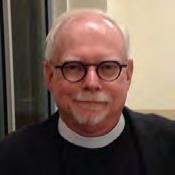
The Convention, hosted by Christ Church in Clermont-Ferrand, France, focuses on this mission in its Festival of Gathering, which includes speakers and workshop leaders and is open to the wider public, both in-person and virtually.
The refugee program has been building since the 2019 Convention, hosted by Emmanuel Episcopal Church in Geneva, when a Convocation task force (now a ministry initiative) was created for assisting migrants and refugees. The 2020 Convention received the report of this task force, “For a Church on the Move,” and work has been extending ever since. This has included the Convocation becoming a member of Churches’ Commission for Migrants in Europe (CCME), a Europe-wide organization. A theologian who works closely with CCME will be among the keynote speakers at the Festival.
As a result of the Ukraine crisis, which has sent some four million refugees westward, the Convocation has received a substantial grant from Episcopal Relief and Development (ERD), to enable our congregations (and other Anglican and full communion partners in continental Europe) to minister to refugees in their areas. This funding will help with immediate needs and allow congregations build capacity to work with refugees in the future. The grant application process is available on the Convocation website. ERD staff members also will speak at the Festival of Gathering.
Within the Convocation, and specifically of St. Paul’s Within the Walls Episcopal Church in Rome, the Joel Nafuma Refugee Center (JNRC), has been working with migrants and refugees in Rome since 1995, providing a model for congregations new to the mission. Giulia Bonoldi, JNRC director, has also joined the Convocation on a part-time basis as Welcoming Officer, and will coordinate the expanded work of the Convocation in this area. The Center is a regular recipient of grants from the United Thank Offering, from various churches in Europe and the United States, and has partnerships with
31



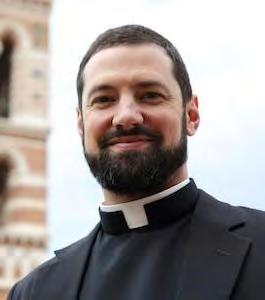
32
“Jesus commissioned his earliest disciples to carry out his mission when in Matthew 10:40 he said:
‘Whoever welcomes you welcomes me, and whoever welcomes me welcomes the one who sent me’.”
THE REV. AUSTIN RIOS RECTOR, ST. PAUL’S WITHIN THE WALLS, ROME.
UNHCR, the U.S. Embassy to the Holy See, Churches Together in Rome and many others. JNRC offers a presence of Christian agape to those most in need, with the help of Episcopal Young Adult Service Corps (YASC) volunteers, who are housed at St. Paul’s.
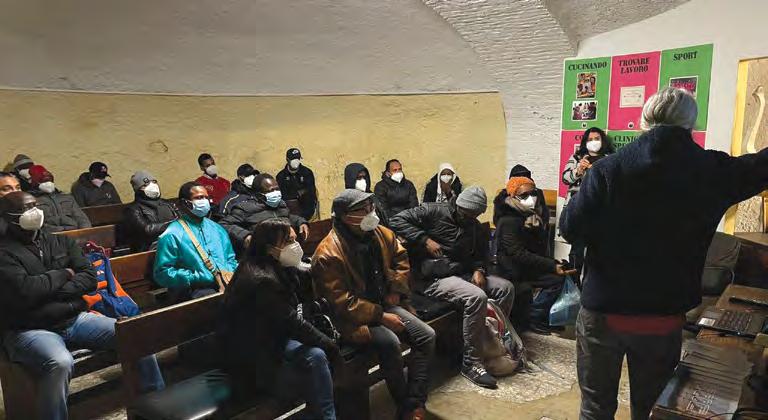
The Rev. Austin Rios, Rector of St. Paul’s Within the Walls, explained to the Episcopal New Service (ENS) the fundamental importance of welcoming refugees. “Christians follow and worship a Lord who not only ‘came down from heaven,’ migrating in the mystery of the Incarnation, but who only days after his birth was forced to flee to a foreign land because of a governmental campaign of infanticide. Jesus experienced both welcome (from Mary and Joseph, shepherds, magi, animals) and rejection (from Herod) from his birth […] a dynamic that would continue throughout his earthly life […].
Jesus commissioned his earliest disciples to carry out his mission when in Matthew 10:40 he said: ‘Whoever welcomes you welcomes me, and whoever welcomes me welcomes the one who sent me’.”
“As inheritors of this tradition of commission, and its attending responsibilities to both receive and extend the hospitality that God has offered us, we are called to offer this welcome as well, especially as it relates to those who are vulnerable because of itinerancy or forced migration,” Rios said. “Not only because welcoming is a proper human response to suffering, but because it is an essential part of our faith DNA. […] Welcoming is never easy; it involves sacrifice. But if we are to believe in God’s promises, then we know that from such sacrifice comes the joyful, abundant and shared life that underwrites our salvation.”
Do keep the Convocation of Episcopal Churches in Europe and its congregations in your prayers as we take up this work in new ways in the coming years.
33
Walter Baer is Archdeacon of the Convocation of Episcopal Churches in Europe, based in Paris.
REFUGEES GETTING INSTRUCTION AT THE JOEL NAFUMA REFUGEE CENTER IN ROME.
by Charles Trueheart
The Right Reverend Peter James Lee, for 25 years the Episcopal Bishop of Virginia, and interim dean of the American Cathedral a decade ago, died in early July 2022 in Chapel Hill, North Carolina, where Peter and his wife, Kristy, had settled in retirement. He was 84.
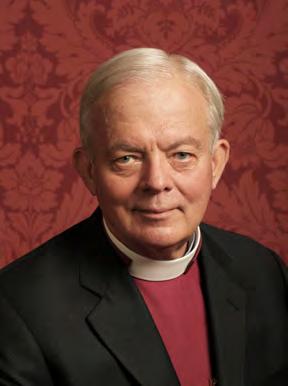
Bishop Peter Lee: a life of standing for hope
Bishop Lee was one of the leading Episcopal clerics of his generation. As bishop of the largest diocese in the church more than 80,000 Episcopalians worshiping in 181 congregations Lee had a natural authority that reached far beyond Virginia.
At his memorial service, the Most Reverend Michael Curry, the presiding bishop of the Episcopal Church, recalled Bishop Lee’s defining role in the ordination of the first openly gay bishop in the denomination nearly two decades ago. An instinctively conservative and non-confrontational bishop, serving in a diocese of widely divergent views on the issue, Lee agonized over his vote to ordain and consecrate the Rev. Eugene Robinson as bishop of New Hampshire. Until then, he had declined to ordain gay and lesbian priests, or marry same-sex couples, in his own diocese.
As The New York Times Magazine told the story at the time, Lee thought and prayed his way to a decision that was sure to antagonize many of his flock. He drew on his youthful experience protesting against racial discrimination in his native South and his close association with many gay and lesbian parishioners and priests over the years.
In the pulpit in Chapel Hill, Bishop Curry recalled the striking moment when Bishop Lee asked his wife what he should do. “Unlike Caesar, unlike Pilate,” Curry said, “Peter listened to his wife. Kristy said, ‘Do you want to be remembered for the past or for the future?’ And Peter would later say publicly he decided not to yield to fear, but to stand for hope.”
Bishop Lee chose the future and voted to approve Robinson’s ordination, but not without costs. Eleven parishes in Virginia left to join the Anglican Church of Nigeria over his vote, and the bishop spent the rest of his episcopate fighting court battles over disputed church properties.
After his retirement, Bishop Lee served leading church institutions in an interim capacity, including the General Theological Seminary in New York, Grace Cathedral in San Francisco, and the American Cathedral in Paris in 2012-2013, during the interregnum between the ninth and tenth deans, Zachary Fleetwood (whom Lee had ordained to the priesthood) and Lucinda Laird.
Peter James Lee was born in Mississippi, raised in Florida, graduated from Washington & Lee University, worked as a newspaper reporter in Memphis and Richmond, and served as a U.S. Army intelligence officer before entering Virginia Theological Seminary. He was ordained to the priesthood in 1968 and served as an associate at St. John’s Church, Lafayette Square, in Washington, before becoming rector of Chapel of the Cross in Chapel Hill, where the July memorial service took place.
34
PHOTO COURTESY OF THE DIOCESE OF VIRGINIA
Dedication of the Battle Memorial Cloister: May 30, 1923

Allied dignitaries joined ranks at The American Cathedral on Memorial Day 1923 for the dedication ceremony of the newly completed Battle Memorial Cloister. The cloister’s four panels, designed by architect Bertram Goodhue with sculptor Michel Tarnowsky, represent some 116,000 Americans killed in World War One. It was the first national monument to U.S. casualties in the war.
Among those attending the ceremony were U.S. Ambassador Myron T. Herrick, former French President Raymond Poincaré, French Marshal Ferdinand Foch, British Field Marshal Sir William Robertson, U.S. General William Wright, Italian General Giovanni Marietti, Belgian General Alphonse Jacques de Dixmude, Cathedral Dean Frederick Beekman and Bishop-in-charge Charles Brent.
the Archives
35
From
BIBLIOTHÈQUE NATIONALE DE FRANCE
Annual Call to Membership
Every fall the ACTM asks parishioners to signify their membership in our community by pledging their financial support for the year. If you’re a newcomer, or haven’t pledged your support yet in 2022, we look forward to hearing from you.
Friends of the Cathedral
Through Friends, members who have moved away, and all who wish to support the mission of the Cathedral, can demonstrate their active commitment. We stay in touch through regular communications – like Trinité magazine – and occasional gatherings in the United States. Please contact friends@americancathedral.org for more information.
Trinité mailing list
If anyone would like to have a paper copy of Trinité magazine mailed to their home address, please send your information to us at communications@americancathedral.org
We’ll be happy to add you to the list!






 by Anne Swardson
by Anne Swardson


 by Ellen Hampton
by Ellen Hampton

















 by Nancy Janin
by Nancy Janin

















